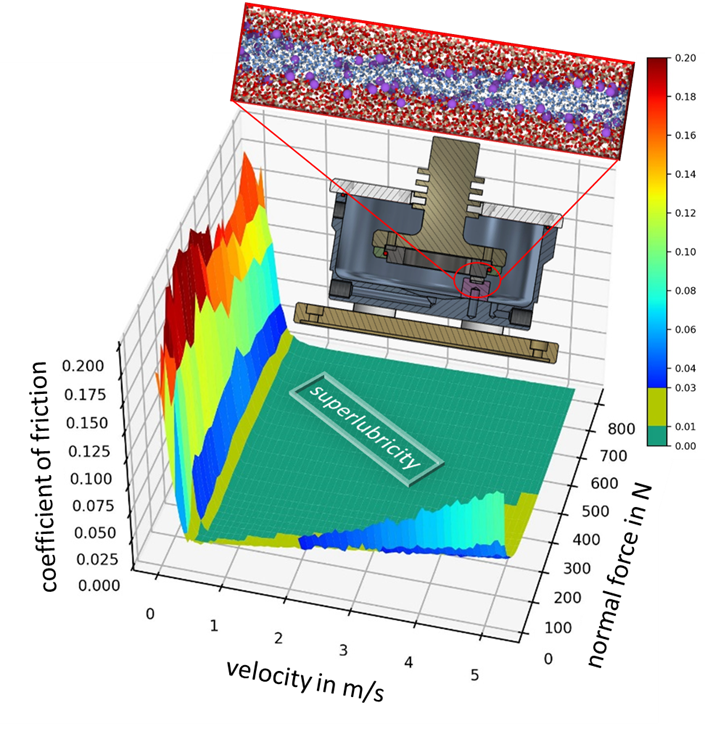Transferring superlubricity from the laboratory into real-world application.
Bringing superlubricity for new slide bearings into application
20 percent of the energy generated worldwide is lost through friction. With new materials, surfaces and lubricants, 40 percent of this energy could be saved in the long term — equivalent to CO2 emissions of more than three gigatons per year! Superlubricity in machine elements is one way to achieve this goal. Fraunhofer researchers are working to bring superlubricity from the laboratory into real-world application.
In technical systems, friction needs to be reduced in rolling or sliding bearings: Slide bearings score points for their simple design and low cost but have coefficients of friction of approximately 0.1 and decreasing energy efficiency at higher speeds. Rolling bearings have friction coefficients of only 0.01, but are more complicated in design, noisier and more expensive. Therefore, despite the higher coefficients of friction, engineers often resort to the simpler slide bearings.
In the future, superlubricity could become a solution for making slide bearings just as resource efficient as rolling bearings: Extremely low coefficients of friction can be achieved if materials, surfaces and lubricants are very well matched. So far, superlubricated systems have only been realized in the laboratory. The challenge is to ensure long-term reliability and temperature stability under practical conditions. In many cases, special materials that are only stable under a specific gas atmosphere are also required.

Superlubricity in application
Researchers from Fraunhofer IWM, IWS, IKTS and IPA are working together on the "SupraSlide" project to bring superlubricity from the laboratory to application. "Our goal is to achieve superlubricity in various applications. In very direct terms, we want to realize simply constructed and cost-effective slide bearings that achieve friction values which reach those of rolling bearings," states Dr. Tobias Amann, deputy group leader at Fraunhofer IWM. Friction values of 0.01 or even lower are the goal. If such a friction value were transferred to a plate on which a five-ton elephant were standing, a human could effortlessly slide the pachyderm together with the plate.
Friction, especially minimal friction, results from the interaction of all the components involved — i.e., the friction body, the surface coating and the lubricant. Many competencies are required to achieve a perfect interplay of these components to reach stable superlubricity in an overall system. "The expertise of the Fraunhofer institutes involved complements each other perfectly," says Amann. Together, Fraunhofer IKTS and IWM are working on the development, production and characterization of suitable ceramic materials. Fraunhofer IWM and IWS provide diamond-like carbon coatings with which the slide bearing surfaces are coated. The team relies on sustainable, water-based lubricants such as glycerol and polyethylene glycols. The evaluation chain that has been set up starts with simple model geometrics to study frictional mechanisms and ends with the demonstration of super-low-friction slide bearings in several technical systems.
The necessary tribological tests are carried out at Fraunhofer IWM and IWS, while Fraunhofer IPA develops and evaluates the demonstrators. To be able to specifically control the friction mechanisms, these must be understood down to the atomic level. "The interface where friction occurs during the slide bearing operation is very difficult to analyze experimentally," explains Dr. Gianpietro Moras, group manager at Fraunhofer IWM. "Therefore, we need multiscale simulations that allow us to elucidate chemical processes or tribological mutations at the surface. Which parameters favor low friction coefficients and what are the mechanisms behind them?"
Building blocks for superlubricated gliders and three demonstrators
The research team has already achieved promising initial results. "We have identified several material and lubricant combinations that achieve superlubricity across a broad load spectrum and have been able to stably maintain this level of friction over a long test period. We have already mastered the step from the model test to the application-oriented test for an axial slide bearing," Moras summarizes. By the end of the project in the spring of 2024, the aim is to have a modular system for superlubricated slide bearings that enable energy savings of 90 percent compared to conventional slide bearings, and three superlubricated demonstrators: the axle of an electric motor for e-bikes, a pump with corresponding slide bearings and mechanical seals, and a positioning system for robotics.
 Fraunhofer Institute for Mechanics of Materials IWM
Fraunhofer Institute for Mechanics of Materials IWM